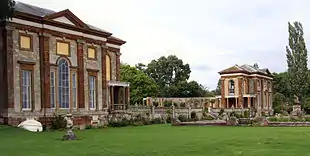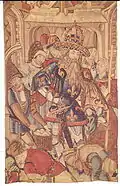Francis Crane
Sir Francis Crane (c. 1579 – c. 1636) was the founder of Mortlake Tapestry Works [1] at Mortlake on the south bank of the river Thames in South West London.
Francis Crane | |
|---|---|
 Stoke Park pavilion | |
| Occupation | Businessman |
Biography
His parentage is obscure, but his family had close links to Cornwall, and both his sisters married Cornishmen.
In April 1606 he had a grant for life of the office of Clerk of the Parliaments, and was secretary to Charles I when the latter was Prince of Wales. During his secretaryship, he was knighted at Coventry on 4 September 1617.[2]
The tapestry works at Mortlake almost ruined Crane, as it involved him in the considerable outlay of capital for an inadequate return, and in 1623 he was forced to appeal to the King, James I for financial help. In that year Crane was making a suite of tapestries for Prince Charles.[3] James I died in 1625 and Crane was given much more favourable terms by the new King, Charles I, whose secretary he had been since 1617.[4] He sat in the Parliaments of 1614 and 1621 as MP for Penryn and that of 1624 for Launceston.[5][6]
In 1629 the King gave him the Manor of Stoke Bruerne in Northamptonshire, where he built Stoke Park, a fine Palladian house, possibly with assistance from Inigo Jones. Building materials for Stoke Bruerne were brought from Grafton Regis where Crane demolished a house built by Henry VIII. He was also appointed c. 1632 the Chancellor of the Order of the Garter.
He died in Paris in 1636 after an operation for bladder stones and was buried at Woodrising in Norfolk, an estate he had purchased from Thomas Southwell.[2]
Family
In 1618 Crane married Mary le Maire, daughter of David le Maire of Tournai, and widow of Henry Swinnerton, but had no issue.[7] He inherited a considerable sum from Mary's brother Sir Peter le Maire, who died in 1631. A rumour that he had been pre-contracted to the Countess of Exeter, which circulated in 1618, was simply one of an extraordinary web of lies spread to damage the Countess by her enemy Lady Lake, wife of Sir Thomas Lake.
His brother and heir, Richard Crane, was created a baronet in 1643. He also left property to his niece Frances Bond. Most of the Crane estates eventually passed to the heirs of his sister Edith, who married Gregory Arundell of Sheviock.
See also
Notes
- Hefford 2008.
- "Sir Francis Crane". Dictionary of National Biography. Retrieved 12 May 2014.
- James Orchard Halliwell, Letters of the Kings of England, vol. 2 (London, 1846), p. 167.
- "Portrait of Crane by Van Dyke auctioned at Sotheby's in 2002 for £227,000". Retrieved 20 August 2008.
- Courtney 1888, pp. 9–10.
- Willis 1750, pp. 177, 188.
- HMC Downshire, vol. 6 (London, 1995), p. 530.
References
- Courtney, William Prideaux (1888). . In Stephen, Leslie (ed.). Dictionary of National Biography. Vol. 13. London: Smith, Elder & Co. pp. 9–10.
- Hefford, Wendy (January 2008) [2004]. "Crane, Francis". Oxford Dictionary of National Biography (online ed.). Oxford University Press. doi:10.1093/ref:odnb/6601. (Subscription or UK public library membership required.)
- Willis, Browne (1750). Notitia Parliamentaria, Part II: A Series or Lists of the Representatives in the several Parliaments held from the Reformation 1541, to the Restoration 1660 ... London. pp. 177, 188.

